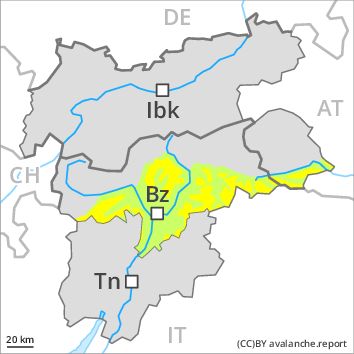Regions
Eastern Pfunderer Mountains, Durreck Range, Western Rieserferner Mountains, Val Müstair Alps, Western Deferegger Alps, Langtaufers, Ortler Range, Schnals Ridge, Southern Stubai Alps, Venediger Range, Southern Zillertal Alps and High Tauern, Eastern Rieserferner Mountains, Saldurn-Mastaun Ridge, Glockner Range, Texel Mountains, Eastern Deferegger Alps, Schober Mountains, Western Pfunderer Mountains

Danger level
Avalanche Problem
Wind-drifted snow above the treeline, N-NE-E-SE-S-SW-W-NW

The fresh snow and wind slabs represent the main danger.
As a consequence of fresh snow and stormy weather the wind slabs will increase in size additionally. The fresh wind slabs are mostly quite large and prone to triggering. They can be released even by a single winter sport participant in all aspects. This applies in particular at their margins. The avalanche prone locations are to be found in particular adjacent to ridgelines and in gullies and bowls in all aspects. At elevated altitudes the avalanche prone locations are more prevalent. In places where more snow falls the avalanche danger is greater.
Avalanches can also penetrate deep layers and reach dangerously large size.
The avalanche prone locations are covered with fresh snow and are difficult to recognise. Backcountry touring calls for caution and restraint. The avalanche situation is a little more favourable in highly frequented off-piste terrain.
Snowpack
dp 6: cold, loose snow and wind
Over a wide area 15 to 25 cm of snow. will fall. As a consequence of the strong wind the previously small wind slabs will increase in size appreciably. In some cases the various wind slabs have bonded still only poorly with each other and the old snowpack. The snowpack will be subject to considerable local variations. The old snowpack will be in some cases prone to triggering. Faceted weak layers exist in the old snowpack. Distinct weak layers in the lower part of the snowpack can be released in some places.
Tendency
Hardly any decrease in avalanche danger. The avalanche prone locations are barely recognisable because of the poor visibility.
